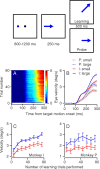Reward action in the initiation of smooth pursuit eye movements
- PMID: 22357868
- PMCID: PMC3327477
- DOI: 10.1523/JNEUROSCI.4676-11.2012
Reward action in the initiation of smooth pursuit eye movements
Abstract
Reward has a powerful influence on motor behavior. To probe how and where reward systems alter motor behavior, we studied smooth pursuit eye movements in monkeys trained to associate the color of a visual cue with the size of the reward to be issued at the end of the target motion. When the tracking task presented two different colored targets that moved orthogonally, monkeys biased the initiation of pursuit toward the direction of motion of the target that led to larger reward. The bias was larger than expected given the modest effects of reward size on tracking of single targets. Experiments with three different reward sizes suggested that the bias afforded a given target depends mainly on the size of the larger reward. To analyze the effect of reward on directional learning in pursuit, monkeys tracked a single moving target that changed direction 250 ms after the onset of motion. Expectation of a larger reward led to a larger learned eye movement during the acquisition of the learned response and during subsequent probes of what had been learned, implying that reward influenced the expression rather than the acquisition of learning. The specific effects of reward size on learning and two-target stimuli imply that the site of reward modulation is at a level where multiple target motions compete for control of eye movement, downstream from sensory processing and learning and upstream from final motor processing.
Figures









References
-
- Basso MA, Pokorny JJ, Liu P. Activity of substantia nigra pars reticulata neurons during smooth pursuit eye movements in monkeys. Eur J Neurosci. 2005;22:448–464. - PubMed
-
- Blodgett HC. The effect of the introduction of reward upon the maze performance of rats. Berkeley, CA: University of California; 1929.
-
- Case GR, Ferrera VP. Coordination of smooth pursuit and saccade target selection in monkeys. J Neurophysiol. 2007;98:2206–2214. - PubMed
Publication types
MeSH terms
Grants and funding
LinkOut - more resources
Full Text Sources
